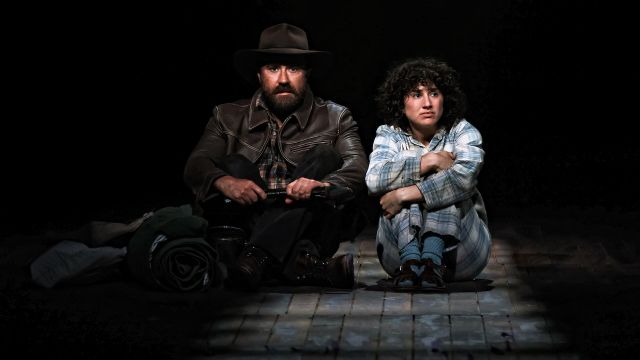The Shiralee
“He had two swags, one of them with legs and a cabbage-tree hat … he had a child and … he was stuck with it.” D’Arcy Niland. “The Shiralee”.
In 1957, as a 14-year-old, I saw the British made film of The Shiralee. It was the first time I’d seen anything about Australia at the “pictures” – and Jim Macauley was depicted as a bit of a hero. I read the book again last week. I had forgotten the how bleakly D’Arcy Niland described life in Australia in the mid 1900s – and the fact that there wasn’t really much “heroic” about Macauley or the way he treated his daughter Buster… until the end!
In this adaptation Kate Mulvany has made no attempt to romanticise what she calls the “horrific murk” of Niland’s book nor Macauley’s “brutal view of the world”. Rather she concentrates on “the lurking violence” and what Buster “teaches her father in their time on the road together”.
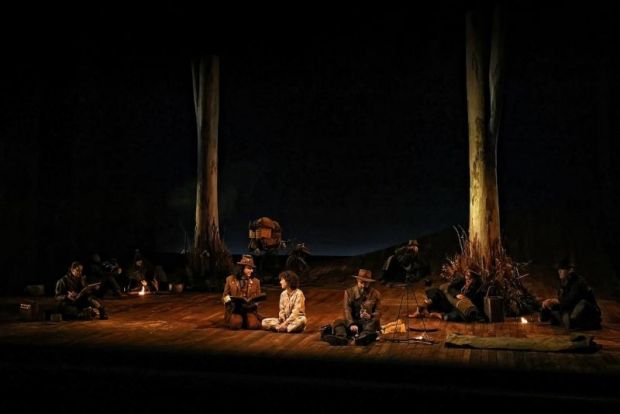
The result is a script that obviously suggested endless possibilities to director Jessica Arthur and her creatives. This Shiralee is set in the “beauty and the terror” of our “wide, brown land” and Arthur’s vision sees it on a wide, brown stage with dark blue night skies, sunrises, “steady soaking rain” … and towering snow gums.
There is poetry in Jeremy Allen’s set design – just as there is in Mulvany’s script. Poetry chronicles Mac and Buster’s journey, spoken by the shadowy figures of others on the road as they sit around sunken campfires or rough shearing shed floors – or move shopfronts, or stretchers or gateways … or towering snow gums.
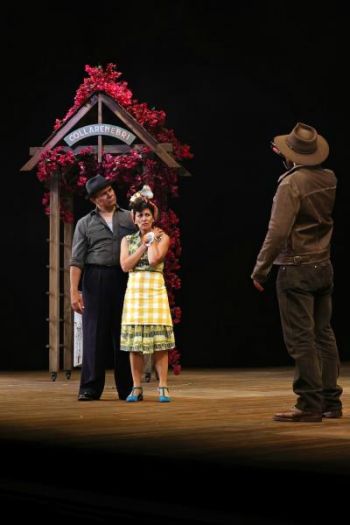
Symbols underscore the production. The characters themselves are figurative symbols of their time – and Allen’s set and costumes, the lighting (Trent Suidgeest) and the sound (Jessica Dunn) vividly conjure an image of the country that made them.
This is Buster and Mac’s story, but Niland peopled that story with other characters that typified Australians of the time – in the bush and the city. Some of them didn’t appear in other iterations of The Shiralee. Mulvany has insured their presence in this one … especially Tommy Goorianawa, the blind all-seeing aboriginal elder who told Macauley “Some men, they can live in a box, but you’re not one of them.”
Josh McConville gives Macauley the restless resentment that Niland suggested in Tommy’s words. His Mac is tough, cruel, fiercely independent. He doesn’t talk much, doesn’t trust anyone, rejects affection – even from Buster. It’s hard to like this harsh man, except every now and again there are tiny cracks in his façade where faltering affection glimmers but quickly disappear. Cracks that Buster works on unknowingly.
Ziggy Resnick makes Buster naïvely wise, her guileless innocence breaking through Mac’s hard veneer with persistent questions, disapproving comments – “You said shit!” – and dogged determination. Some of the dialogue is straight from the novel. Some from Mulvany’s slightly more mature, knowing Buster who is funny, a bit bold, and who Resnik plays with cheeky energy and sometimes childish glee – especially as she teases her father with repetitions of “I like Aeroplane jelly”, or copies the laugh of a stranger.
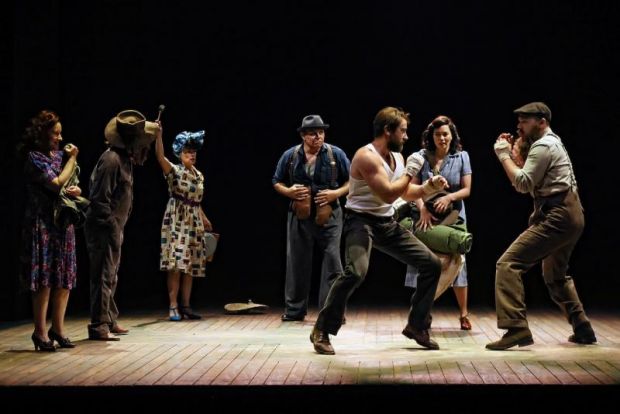
Kate Mulvany herself plays Buster’s mother Marge, a woman left alone for months on end, waiting for mail that might bring money from Macauley to feed and clothe their daughter – and pay rent to the lonely landlord. Mulvany finds both resentment and passion in Marge – and some compassion.
The landlord is Marge’s lover, who Macauley bashes in a bitter rage. Stephen Andersen finds both fear and cunning in this character … as well as depicting other characters along the road like generous shopkeeper, Cheetham – “Only by name, not by nature.”
Tommy Goorianawa, played vey convincingly by Aaron Pedersen, sits guarding a waterspout. Pedersen makes him funny as well as wise, especially in a little bit of gentle fun with Buster that is indicative of Arthurs’s creative imagination. There is gentle spirituality in Pedersen’s Tommy that spooks Macauley and fascinates Buster.
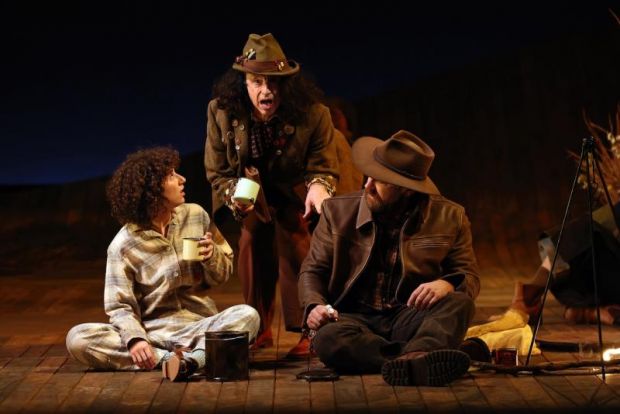
Paul Capsis is endearing as writer/storyteller, Desmond, gently creeping into Buster’s imagination – and even breaking through Macauley’s cold veneer. His persistent calm and mellowness are beautiful contrasts to Macauley’s jumpy awareness.
Lucia Mastrantone is clever, as always, in all of the roles she plays. She is squeakily endearing as Beauty’s (Pedersen) wife Bella, and kindly caring as a bush poet.
Catherine Vǎn-Davies plays the other women in Macauley’s life, among them Lily who waits patiently for the man she hopes will come back to Grafton. One day.
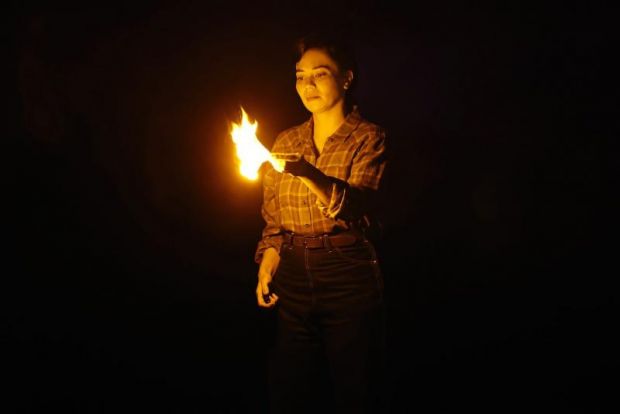
All of the cast apart from McConville and Resnik become the characters who travel the bush roads, or work in shearing sheds, or share the poetry written about them in papers and magazines published in the city.
Kate Mulvany re-captured city life in the 1940s with her adaptations of Ruth Park’s Harp in the South. In The Shiralee the loneliness of the dusty country roads pervades her stage. Jessica Arthur, her cast and her creative team have breathed life into her adaptation of this “gritty tale of an Australia that was fading away” an Australia where …
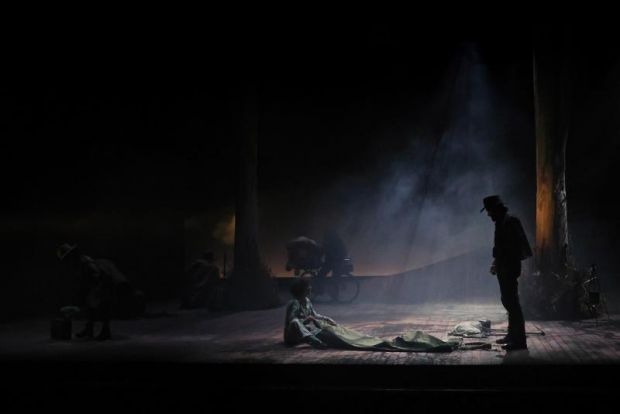
The swagman crawls across the plain.
The drought it prowls beside him,
A hundred miles from rim to rim,
A shadow stick to guide him.”
The Ballad of the Shiralee: Ruth Park
Review by Carol Wimmer
Photographer: Prudence Upton
Subscribe to our E-Newsletter, buy our latest print edition or find a Performing Arts book at Book Nook.

